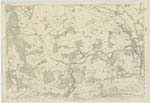OS1/1/42/55
| List of names as written | Various modes of spelling | Authorities for spelling | Situation | Description remarks |
|---|---|---|---|---|
| THE BASS | The Bass The Bass The Bass The Bass |
Revd. [Reverend] Mr. Davidson Dr. [Doctor] Leslie. Mr. Bisset. Mr. W. Taylor. |
054 | A little to the east of the Bridge of Don stands the Bass of Inverury, a conical mound, apparently about 50 or 60 feet high, and of proportionate diameter. Different hypotheses have been formed respecting this mysterious structure. The writer of the Statistical Account concludes that it is the grave of * King Aoch, son of Kenneth II, who died here in 881. Others conjecture that it formed one of a series of signal towers from the coast to Kildrummy. The current local tradition is that the plague was buried within it, and a not uncommon superstition entertained among the less educated is that if opened, it would prove a kind of Pandora's box, and disperse the seeds of all imaginable distempers. It has been suggested that in this popular belief may be found a clue to the real nature of the mound. Let it be supposed it is observed, that the plague mentioned was a moral plague - in short that the mound contains some of the objects of ancient idolatry, and thus you have a rational explanation of the erection. There is this much to be said in favour of the view, that recent excavations of the similar structure termed the Castle-hill of Kintore disclose several stones covered with hieroglyphics, which may either have marked the sites of altars, or themselves been objects of worship. Possibly the sculptured stones taken from the Castle-hill at Kintore, engravings of which are now in the hands of the Spalding Club, may tend to elucidate something as to the uses and purposes, not only of the erection at Kintore, but of the mystic mound that marks the junction of the Don and Ury. It would be unpardonable, of course, were we here (over) [Continued] |
Continued entries/extra info
[Page] 55Ph [Parish] of Inverury
*This man is also said by some to be buried under the "Conyng Hillock" in this Parish (see Page 41). E.H.C. Capt. R.E. [Captain Royal Engineers]
Note.
Mr. Stuart the able Secretary to the Antiquarian Society (Scot.) believes the Bass to be a natural deposit, (altho' [although] the general belief is that it is purely artificial), scarped and shaped to receive one of the early forts of wood of which down to the 13th Century we have notices in Scottish Annals, where they are called "Munitiones ligneol". I confess that I am inclined to agree with him, & have little doubt that the castle* was once erected on it. The Bass is exactly a similar structure to the "Doune of Invernochty" also in the County of Aberdeen. E.H.C. Capt. R.E. [Captain Royal Engineers]
*Mentioned at Page 51
Transcriber's notes
"Munitiones Ligneol" Latin for 'wooden fortifications'Transcribers who have contributed to this page.
Kate51- Moderator, Geoffrey M Gill
Location information for this page.
Linked mapsheets.




